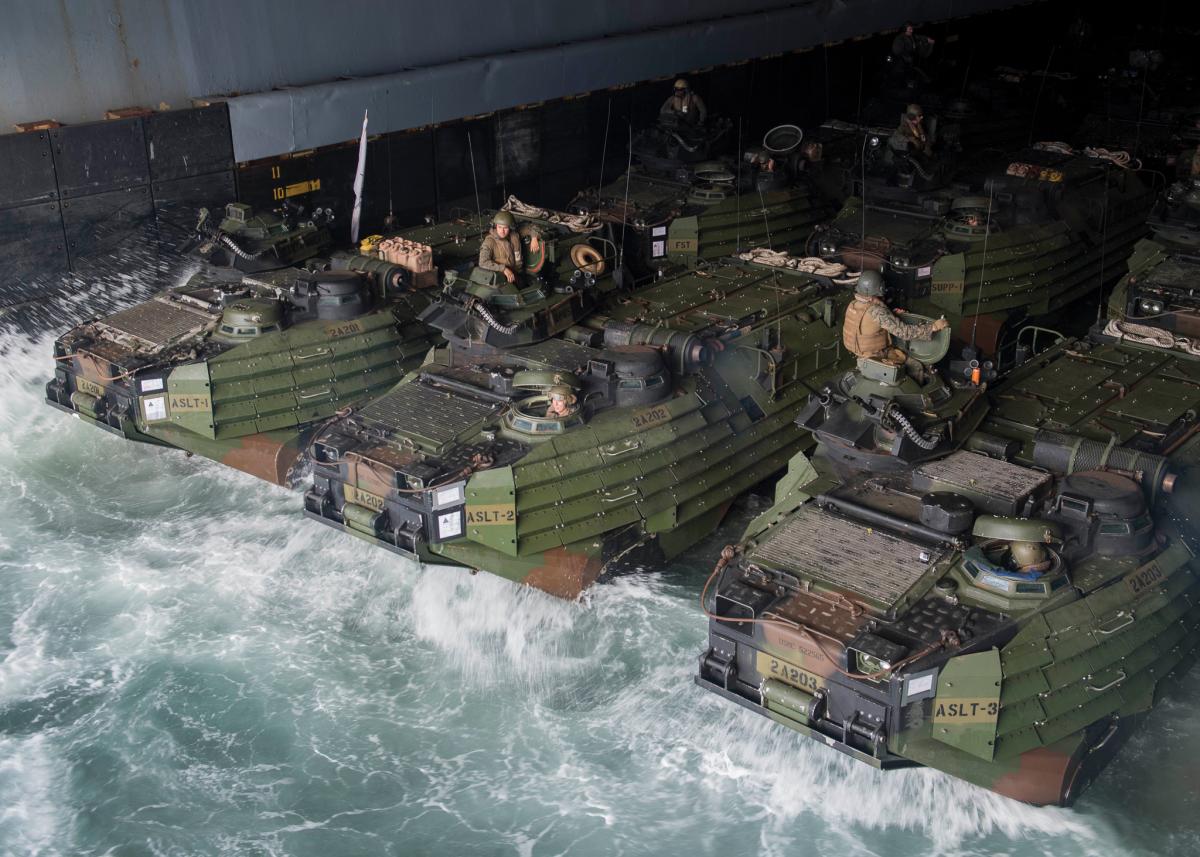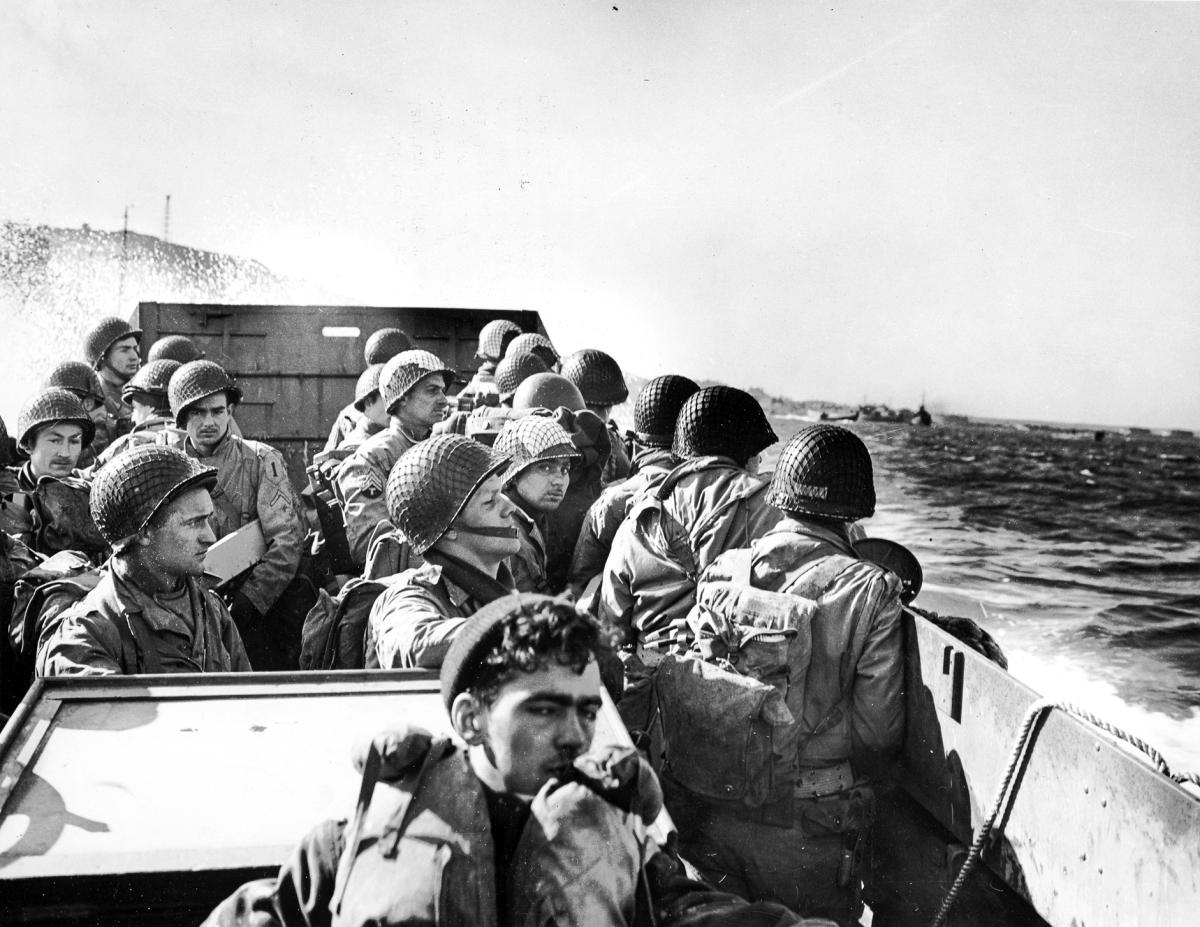The 2018 National Defense Strategy (NDS) marks a clear turn in U.S. policy toward preparation to face potential adversary states. China, Russia, North Korea, and Iran present vastly different threats that would require radically divergent courses of action should a conflict arise.
What these adversaries have in common, however, is proximity to key maritime terrain. China, Russia, and Iran also have extensive integrated coastal defense systems (also called antiaccess/area-denial systems) that cannot be reduced from the sea and air alone. Ground forces would be required to seize, hold, and control coastal terrain. That will not be not possible without amphibious capabilities.
U.S. amphibious capacity has been in decline for decades as the number of amphibious warships and protected surface connectors has fallen. The Navy would need upward of 50 amphibious warships to meet joint force requirements.1 Of the 32 amphibious ships currently in the inventory, only 16 are able to support operations at any one time.2 The only armored connector in the inventory is the Marine Corps’ advanced amphibious vehicle, of 1980s vintage. The Navy and the Army also maintain fleets of unarmored connectors for over-the-shore logistics, but they can be used only in permissive conditions.
The Navy and the Marine Corps need a sustained effort to modernize amphibious warfare concepts, doctrine, and platforms. To achieve this, they will need to work with the U.S. Army.
Falling Behind
Restoring and modernizing amphibious capabilities is vital, because conflict with any of the potential adversaries identified in the NDS would require the joint force to take and hold key maritime terrain, in the form of islands, littorals, and mainland beachheads. China places great importance on the island chains surrounding the East and South China seas—which it has designated the first and second island chains—and it has tripled the size of its marine corps in an effort to control them.3 The ongoing effort to construct artificial islands speaks to Chinese intentions to gain influence in the seas in their near abroad. In addition, many key islands are too large for U.S. Marine Corps forces alone to seize, hold, and control. By necessity, the Army will be heavily involved in any naval campaign in the Pacific region.
The need for amphibious operations is most obvious when it comes to China, but Russia, North Korea, and Iran all have extensive coastlines near important sea lines of communication. Russia’s recent invasion of Ukraine secured additional key maritime terrain. Islands and chokepoints are numerous in both the Baltic and Black seas nearest Russia.
Should conflict occur with North Korea, the United States could most easily strike on that nation’s flanks, requiring amphibious force projection to outflank the southward defenses. Those coasts, however, also can be defended, and many islands off North Korea’s shore offer opportunities for defenders and attackers.
Iran’s coastline also features an array of islands and restricted waterways, and Iranian efforts to exert control over the Persian Gulf stretch back to the 1970s. If Iran were to control the Gulf, the consequences would be dire for the global economy, and any intervention would necessitate amphibious operations.
Putting the Band Back Together
During World War II, the Navy, Marine Corps, and Army operated with a common amphibious warfare doctrine based on shared amphibious concepts and platforms. To regain the ability to conduct joint forcible entry operations, they will have to do so again.
First, the Marine Corps must accept that the Army will be involved in conducting amphibious warfare in support of land campaigns or augmenting Marine forces during naval campaigns. Undue territoriality when it comes to amphibious warfare hinders readiness; Army logistics can only enhance the reach and combat power of Marine Corps forces.
The Marine Corps also must redouble efforts toward naval integration, but the Navy must meet the Corps halfway. The Navy should reassess what it needs from the Marine Corps, given the proliferation of precision-guided munitions and their centrality in naval warfare and its own efforts to increase its lethality at sea. A better understanding of Navy needs will help the Marine Corps ensure it has the necessary capabilities to conduct its primary mission. The Navy also should join with the Marine Corps to investigate alternative surface connectors to ensure the ability to project force ashore.4
For its part, the Army must restore its amphibious warfare capability by creating an Army Maritime Command at Fort Story, Virginia.5 Fort Story is the last Army post with a shoreline and once hosted Army amphibious exercises. It is close to Naval Station Norfolk and Marine Corps Base Quantico and thus could host triservice experimentation, concept development, and planning. The Army Maritime Command would be responsible for the roughly 300 Army watercraft and 2,000 soldiers who serve as marine deck officers and marine engineering officers.6 In addition, Army airborne capabilities working in tandem with amphibious operations will be in high demand in any conflict in the Pacific.7
The Corps and the Army then should join together to produce the second and follow-on phases of the amphibious combat vehicle (ACV) program.8 The Army will take on amphibious operations in littoral regions—especially when it comes to the larger islands—and the Marine Corps does not have enough armored surface connectors for itself, let alone to share. Both problems can be solved by producing one ACV for both services during phase 2 of the program. The prototype variants of the ACV also offer technology that would be useful for other Army vehicle programs.9 The Army Maritime Command can maintain the Army’s fleet of ACVs while providing a venue for Army units to train with them at Fort Story.
The Air Force also has a key role to play: securing command of the air and using that command to reduce enemy shore emplacements and threats. One investment could enhance the Air Force’s utility in amphibious operations: seaplanes. In many environments, but especially the Pacific, U.S. amphibious forces will need to occupy small islands in dispersed locations. Those forces will need to be resupplied, and seaplanes offer a way to move forces and supplies by using the sea as an airstrip. China already has recognized this opportunity and is developing seaplanes for maritime logistics.10 The Air Force should follow suit.
In the past, when faced with the need to develop new concepts and modernize a key capability within fiscal constraints, the Navy, Marine Corps, and Army did so by working together. Coming together to share conceptual development, doctrine, and platform investment is the most cost-effective way to begin amphibious innovation and to ensure joint force access anywhere in the world. Joint forcible entry capabilities will only fall behind until a sustained effort to ensure them has begun.
Learning from the Past
The modern era of amphibious warfare began with a triservice effort during the interwar years of the early 20th century, allowing the United States to leap ahead of other nations in amphibious power and reach. Even before World War I, the Marine Corps was experimenting with new roles and missions in response to the Navy’s needs, with Captain Earl “Pete” Ellis developing the concept of advanced base operations while at the Naval War College in 1912–13.1 The concept was tested through experiments, the Fleet Marine Force was designed to execute it, and it was captured in “Advanced Base Operations in Micronesia”—part of War Plan Orange—and the “Tentative Manual for Landing Operations,” subsequently adopted by both the Navy and the Army prior to World War II.
The Navy’s interest in advanced base operations was driven by the need for coaling stations. By World War II, airfields were a greater need. Airfields were a primary component of sea control because they provided platforms for launching strike and reconnaissance aircraft. To fight in the Pacific, the naval services developed a synergistic relationship: The Marine Corps needed the Navy to provide lift, fire support, and logistics, and the Navy needed Marines to take and hold bases. This relationship persists, but the missile age has introduced a new requirement: taking and holding bases as platforms for missile defense, air defense, and antiship missiles.
Although the military contracted after World War II, it did not relinquish its amphibious warfare advantage. The Korean War confirmed its utility and importance. In 1996 and 1997, the Marine Corps codified operational maneuver from the sea and ship-to-objective maneuver, and the Navy/Marine Corps team is still innovating. Nascent concepts such as littoral operations in a contested environment, distributed lethality, and expeditionary advanced base operations guide research and investment in capabilities to maneuver and persist in restricted coastal waters.
The story has not been the same for the Army. By World War II, the Army had a long history of amphibious warfare, but despite being tasked with maintaining amphibious warfare capability, it has jettisoned that institutional knowledge and capability. The last Army amphibious doctrine was published in November 1966. The last Army amphibious exercise occurred in August 1964; currently, it maintains amphibious vessels for logistics, but not for assault troops.2 These vessels cannot be used in nonpermissive environments, and they are not used even in permissive environments such as humanitarian and disaster relief operations.3
1. Ronald O’Rourke, “Navy LPD-15 Flight II (LX[R]) Amphibious Ship Program: Background and Issues for Congress” (Washington, DC: Congressional Research Service, 2018).
2. The Heritage Foundation, “An Assessment of U.S. Military Power: U.S. Marine Corps” (Washington, DC: The Heritage Foundation, 2018).
3. Michael Peck, “China Is Tripling the Size of Its Marine Corps,” The National Interest, 29 August 2018.
4. COL Douglas King, USMC (Ret.), and MAJ B. A. Friedman, USNR, “Fighting Forward to Ensure Littoral Access,” U.S. Naval Institute Proceedings 143, no. 11 (November 2017).
5. CW04 Michael Carr, USN (Ret.), “Save the Army’s ‘Navy’,” U.S. Naval Institute Proceedings (September 2018).
6. Carr, “Save the Army’s Navy.”
7. LCOL Jason B Nicholson, USA, and Joseph Trevithick, “The Army’s New Role in the Pacific Pivot,” U.S. Naval Institute Proceedings 141, no. 10 (October 2015).
8. Congressional Research Service, “Report to Congress on Marine Corps Amphibious Combat Vehicle Program” (Washington, DC: Congressional Research Service, 26 September 2018).
9. Todd South, “Is This the Marine Corps’ Next Amphibious Combat Vehicle?” Marine Corps Times, 27 September 2018.
10. Ralph Jennings, “China’s Record-sized Seaplane Beats Rivals from Japan and Russia,” Forbes, 26 December 2017.
Learning from the Past
1. B. A. Friedman, 21st Century Ellis: Operational Art and Strategic Prophecy (Annapolis, MD: Naval Institute Press, 2015).
2. Joseph E. Malone, The Army and the Need for an Amphibious Capability (Fort Leavenworth, KS: School of Advanced Military Studies, 2015), 37.
3. CW04 Michael Carr, USN (Ret.), “Save the Army’s ‘Navy’,” U.S. Naval Institute Proceedings (September 2018).
Now listen to Maj. Friedman talk about where we need to up our amphibious warfare game, including getting the Army involved again, on Episode 70 of the Proceedings Podcast.




